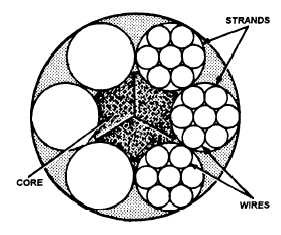CHAPTER 13
RIGGING
Rigging is a technique of handling materials using
wire rope, fiber rope, chains, slings, spreader bars, and
so forth. Rigging is a vital link in the weight-handling
process.
In the Naval Construction Force (NCF), an in-depth
management program for maintenance and use of all
rigging gear is required to ensure the entire
weight-handling operations are performed safely and
professionally. These guidelines are outlined in the
COMSECOND/COMTHIRDNCBINST 11200.11,
Use of Wire Rope Slings and Rigging Hardware in the
Naval Construction Force.
This chapter covers the characteristics, mainte-
nance, usage, and storage of rigging gear used in
weight-handling operations.
WIRE ROPE
Many of the movable components on cranes and
attachments are moved by wire rope. Wire rope is a
complex machine, composed of a number of precise,
moving parts. The moving parts of wire rope are
designed and manufactured to bear a definite
relationship to one another to have the necessary
flexibility during operation.
Wire rope may be manufactured by either of two
methods. If the strands, or wires, are shaped to conform
to the curvature of the finished rope before laying up,
the rope is termed preformed wire rope. If they are not
shaped before fabrication, the wire rope is termed
non-preformed wire rope.
The most common type of manufactured wire rope
is preformed. When cut, the wire rope tends not to unlay
and is more flexible than non-preformed wire rope. With
non-preformed wire rope, twisting produces a stress in
the wires; therefore, when it is cut or broken, the stress
causes the strands to unlay.
NOTE: When the wire is cut or broken, the almost
instantaneous unlaying of the wires and strands of
non-preformed wire rope can cause serious injury to
someone that is careless or not familiar with this
characteristic of the rope.
PARTS OF WIRE ROPE
Wire rope is composed of three parts: wires,
strands, and core (fig. 13- 1). A predetermined number
of wires of the same or different size are fabricated in a
uniform arrangement of definite lay to form a strand.
The required number of strands are then laid together
symmetrically around the core to form the wire rope.
Wire
The basic component of the wire rope is the wire.
The wire may be made of steel, iron, or other metal
in various sizes. The number of wires to a strand
varies, depending on the purpose for which the wire
rope is intended. Wire rope is designated by the
number of strands per rope and the number of wires per
strand. Thus an 1/2-inch 6 x 19 rope has six strands with
19 wires per strand. It has the same outside diameter as
a 1/2-inch 6 x 37 rope that has six strands with 37 wires
(of smaller size) per strand.
Strand
The design arrangement of a strand is called the
construction. The wires in the strand maybe all the same
size or a mixture of sizes. The most common strand
Figure 13-1.—Parts of wire rope.
13-1


